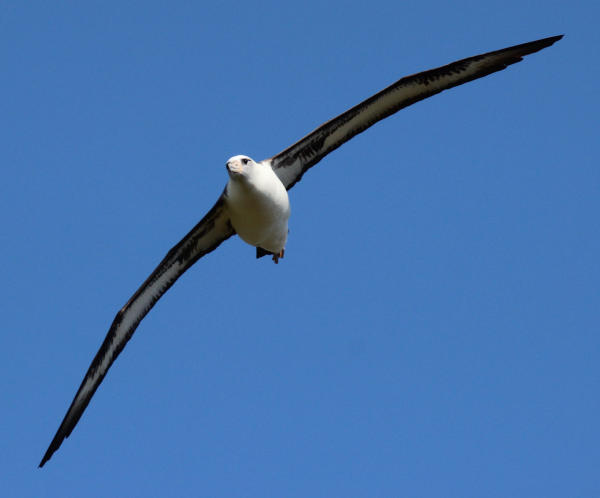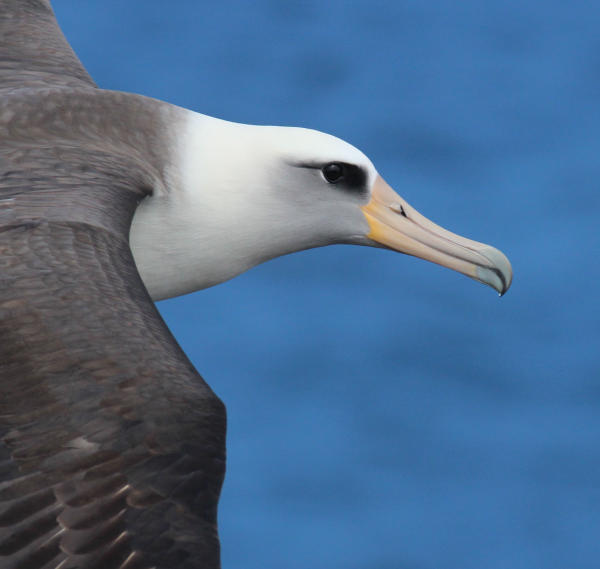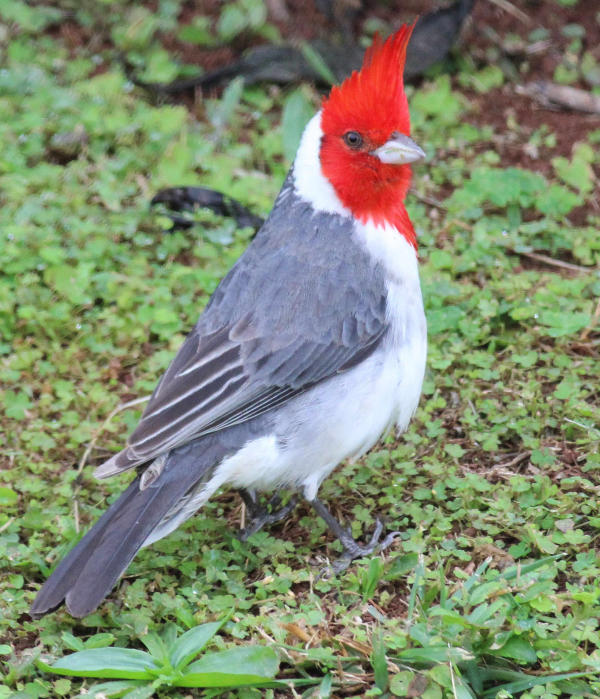
NeNes, the state birds of Hawaii, are favorites of many visiting birders.

The ultimate glider, a Laysan Albatross shears the wind along the cliffs of Kilauea Point.

Where else can you get an up-close and personal look at a Laysan Albatross?

A colorful example of an introduced species, a Red-crested Cardinal is native to south-central South America.
|
Once visited, Hawaii beckons visitors back almost daily. It’s a state that offers a remarkable impression of paradise. For birders, each of these remarkable islands provides an exciting opportunity to find, study and photograph birds that are mostly unfamiliar to mainlanders – which makes it all the more appealing to people seeking a tropical island vacation with their binoculars and camera in hand.
My favorite Hawaiian island is Kauai, the western-most of the four principal isles. Kauai offers a wonderful mix of native birds, introduced species and seabirds. At the same time it has a mixture of habitats to explore, including mountain forests, freshwater wetlands, ocean cliffs and beaches, open oceans, urban environs and some croplands.
Island birds offer excitement around every corner, but I must admit, I found my two favorite birding locations my first day on the island, both along the North Shore within easy reach of the quaint village of Hanalei. In the lush green lowlands, river and ponds of Hanalei National Wildlife Refuge, I enjoyed photographing Hawaii’s national birds, the NeNes, beautiful Hawaiian geese that have happily made a comeback from near-extinction. NeNes are especially fun to observe and I had great luck photographing them. Hawaiian Gallinules and Hawaiian Ducks were also fairly common in the area.
The northern-most point of Kauai is a promontory cliff jutting into the Pacific and topped by a classic lighthouse. Access to the top of the cliff at Kilauea Point National Wildlife Refuge provided close encounters with an exciting mix of seabirds, including Laysan Albatrosses, Red-tailed and White-tailed Tropicbirds, Red-footed and Brown Boobys, and Great Frigatebirds, although other seabirds may be found there too. Adding to the excitement of the location are sightings of Humpback Whales in the coastal waters below the cliffs during winter and spring.
Between these two areas I encountered a variety of introduced birds from Asia, South America and the United States. While these species are not native, they have become part of the wild bird communities and it is great fun to observe and try to photograph these species, mostly small finches, and including our mainland Northern Cardinals. Other species included the South American Red-crested Cardinals and Asian Common Mynas, Java Sparrows, Scaly-breasted Munias and more. And in open grasslands and beaches, you can find the primary wintering species in season – Pacific Golden Plovers – that nest in western Alaska and winter on Pacific Islands from Hawaii to Tahiti.
On the west side of the island is a true Hawaiian wilderness area, the Alakai Swamp, although it is more of a mountain forest than a swamp. It’s also known as one of the rainiest locations in the world, so be prepared, even if the weather is fine at the beach. You can access the western edge of the Alakai and many hiking trails from Koke’e State Park, and be ready for some serious hiking on any of the trails.
This is also where you can find the remarkable native birds amid the native forests – the Hawaiian honeycreepers and associated birds including beautiful yellow Kauai Amakihi, Anianiau, Kauai Eleopaio and several more. Birding in this area is hard; the birds are few and far between, they are usually very high in the forest canopy, but when you do find one of the native gems, a bright red I’iwi or Apapane, for example, it’s well worth the effort you made to visit this unique mountain birding location on Kauai.
If you’re looking for an easy birding getaway, Kauai is a perfect destination, with economic rental cars, an excellent road system, and a variety of hotel and culinary options. Although there are plenty of luxurious resorts you can choose from, during my most recent trip to Hawaii (my first trip to Kauai), I decided to rough it a bit, staying at some small economy hotels. I was birding all day every day, so really just needed a bed to sleep in and a shower. I didn’t book a room in advance; I was able to get a hotel room wherever I ended up at the end of the day, which is not always possible during the peak winter season.
Before we say aloha to Kauai, I would be remiss if I didn’t mention one of the most obvious of Kauai’s birds – the descendants of Asian junglefowl – domestic chickens. Well, they’re kind of domestic. Kauai’s chickens come in every shape and color you can imagine, and frankly, they are enchanting and a colorful addition to the island’s avifauna. In Hawaii, I don’t bemoan the introduced species; I embrace them as part of the Kauai birding experience, then concentrate on the species I enjoy most – whatever birds are within sight.
Are you ready for a Hawaiian birding holiday? Consider my favorite island, but there’s always Oahu, Maui and the Big Island – Enjoy, and Mahalo!
Article and photographs by Paul Konrad
Share your birding experiences at editorstbw2@gmail.com